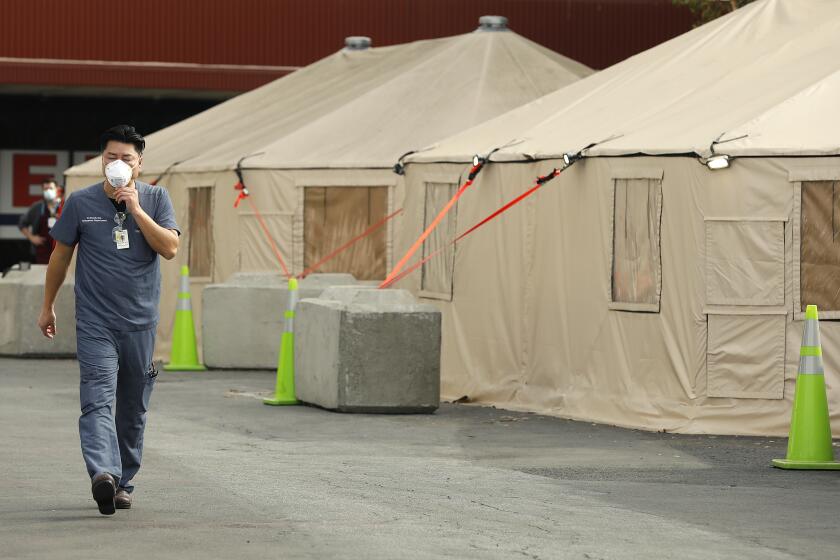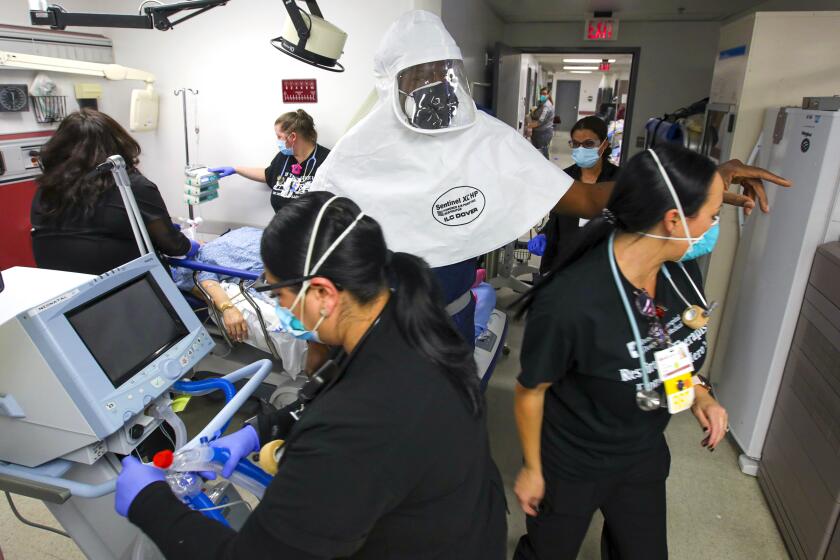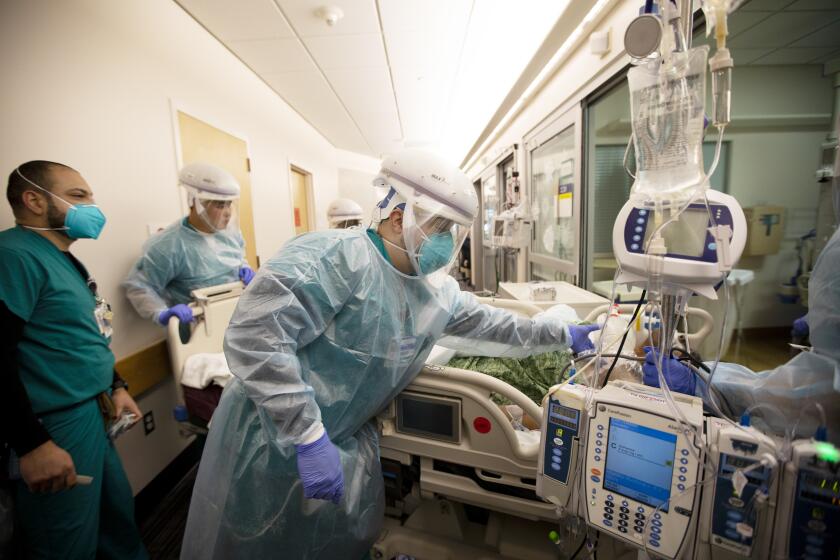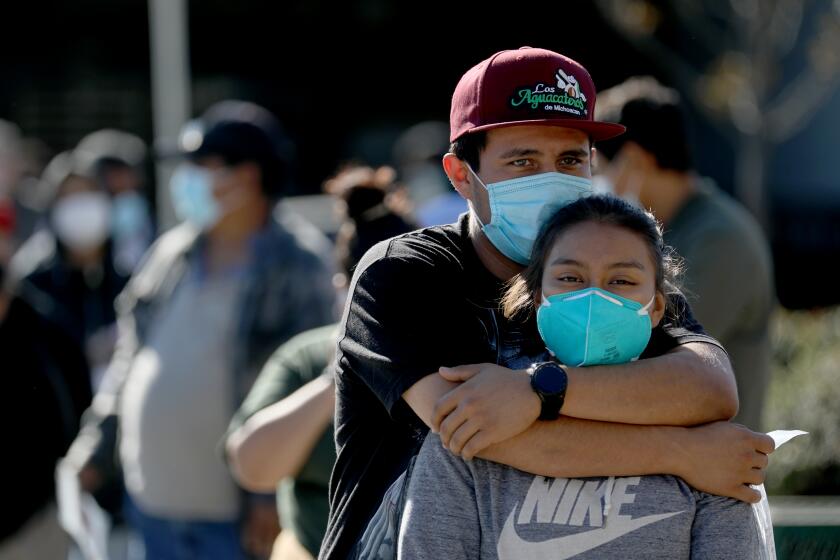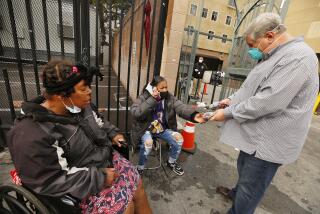Coronavirus stay-home orders likely to be extended in Southern California

- Share via
Sweeping restrictions on businesses and activities are expected to remain in place past their original expiration date across a wide swath of California, as the availability of precious intensive care beds continues to dwindle in the face of an unrelenting COVID-19 surge, state officials said.
Though nothing is definite yet, Gov. Gavin Newsom acknowledged Monday that the stay-at-home orders issued for Southern California and the San Joaquin Valley will probably need to be extended.
The two regions — which combined cover 23 of California’s 58 counties — are technically eligible to emerge from the state order beginning next week.
However, as Newsom noted, it’s doubtful either will do so, as both have seen a steady erosion in their stocks of intensive care unit beds that are available to treat COVID-19 patients.
California once again shattered its daily record for the number of coronavirus cases in a single day. A county-by-county tally conducted by The Times for Monday found 62,661 new coronavirus cases reported — the most in a single day since Friday, when 53,326 coronavirus cases were reported.
The state is now averaging nearly 45,000 new coronavirus cases a day over the last week — more than seven times the comparable figure from six weeks ago.
As of Monday, the ICU availability in both Southern California and the San Joaquin Valley remained at 0%, state figures show.
Orange County reports its highest daily number of coronavirus cases over the weekend.
That doesn’t mean there are no unoccupied ICU beds at all, as the state uses a weighted formula to ensure that some remain open for non-COVID patients. However, officials and experts warn that an overcrowded ICU can overburden doctors and nurses, imperiling the quality of care for everyone from COVID-19 patients to heart attack victims to those who were seriously injured in a car accident.
“It’s very likely, based on those current trends, that we’ll need to extend that stay-at-home order,” Newsom said during a briefing.
Such an order is implemented when ICU availability falls below 15% within a state-defined region, as has happened in Southern California, the San Joaquin Valley, Greater Sacramento and the Bay Area.
So far, only rural Northern California has been able to avoid the additional restrictions — which include reduced capacity at retail stores; the closure of some businesses including hair salons, nail salons, card rooms, museums, zoos and aquariums; and a prohibition on most gatherings, hotel stays for tourism and outdoor restaurant dining.
Already, hospitals are struggling to keep up with the pace of new COVID-19 patients. With the surge showing no signs of slowing down, L.A. County facilities are preparing for how to allocate care in a crisis situation.
Regional stay-at-home orders have a mandatory three-week lifespan. After that, they can be lifted depending on a specific region’s expected conditions in the near future.
“At the moment our projections don’t show that any of the regions that could first exit the regional stay-at-home order will likely do that,” Dr. Mark Ghaly, California’s health and human services secretary, said during Monday’s briefing. “But, as they say, we will only make that call when we actually do the calculations, when the time is right.”
The specifics of that remain a bit murky, however. According to the state, the orders “will remain in effect in a region if its ICU capacity projected out four weeks ... is less than 15%.”
“The order will remain in effect until the region’s projected ICU capacity is equal or greater than 15%,” per the state guidance. “This would be assessed approximately twice a week.”
It remains unclear, though, whether a region would be required to remain under the order for a set period of time following the initial calculation, or whether the restrictions could be lifted as soon as projections come in above the established threshold.
The California Health and Human Services Agency did not immediately respond to a request for clarification Monday afternoon.
Doctors are preparing to ration care as COVID-19 patients overwhelm healthcare systems.
The prospect of extending the restrictions, though unwelcome in many corners, is not surprising given the continued havoc the coronavirus is wreaking throughout the state.
More Californians are dying from the disease than ever before. The state has averaged 233 daily deaths over the last week, more than double the number two weeks ago, according to data compiled by The Times.
More than 2,700 Californians have died from COVID-19 over the last 14 days, a staggering number that accounts for 12% of the state’s 22,600-plus fatalities.
Those numbers serve as a “sober, sober reminder of how deadly this disease is, and how tragic the loss of every life is,” Newsom said.
Newly confirmed coronavirus infections have soared to levels first unprecedented, then unthinkable in recent weeks, and hospitals are struggling to keep pace with the flood of COVID-19 patients packing their emergency rooms.
“Our hospitals are already over capacity, and the high-quality medical care we’re accustomed to in L.A. County is beginning to be compromised as our frontline healthcare workers are beyond stretched to the limit,” county Public Health Director Barbara Ferrer said during a briefing Monday.
As of Sunday, the most recent day for which complete data are available, there were 5,866 coronavirus-positive patients hospitalized in L.A. County — accounting for roughly a third of the statewide total of 17,190.
The number of Angelenos battling COVID-19 in the ICU, 1,202, is the highest it’s ever been, according to figures from the state.
The region’s hospitals are “under siege and under immense pressure,” said Dr. Christina Ghaly, the county’s director of health services.
The number of available ICU beds countywide had dwindled to 30 as of Sunday morning, she said. Though that figure changes constantly as patients are admitted, discharged or die, it still illustrates the extent to which hospitals are being overtaxed and their employees being overworked.
“I’ve been a physician for almost 20 years. There’s not any situation that I have seen in which hospitals are, across the board, affected in the way that they’re affected right now,” Christina Ghaly said.
And officials have said they fully expect things to get worse.
The state’s March restrictions flattened the coronavirus curve, but the latest order must tame an infection rate that is already wildly out of control.
Because of the lagging nature of the coronavirus, today’s hospitalizations largely reflect people who were infected two to three weeks ago — when case numbers, though high, were significantly lower than they are today.
Going off of the recent record-high average of more than 14,000 new cases per day, Ferrer said L.A. County could see 7,000-plus COVID-19 hospitalizations two weeks from now, with the resulting number of daily deaths potentially topping 110.
Staving off that “surge on top of a surge on top of a surge,” Ferrer said, requires everyone, residents and businesses alike, to use all the tools at their disposal to protect themselves and their loved ones from becoming infected.
That means wearing face masks in public, staying home when you’re sick and regularly washing your hands. Most critically, officials also stress that residents should stay home as much as possible — and avoid gathering with those they don’t live with, even for the holidays.
Too many people failed to heed that call when it came to celebrating Thanksgiving, Ferrer said, and doing so again for Christmas or New Year’s could have devastating results.
“Another spike in cases from the winter holidays will be disastrous for our hospital system and, ultimately, will mean many more people simply won’t be with us in 2021,” she said.
Times staff writer John Myers contributed to this report.
More to Read
Sign up for Essential California
The most important California stories and recommendations in your inbox every morning.
You may occasionally receive promotional content from the Los Angeles Times.
